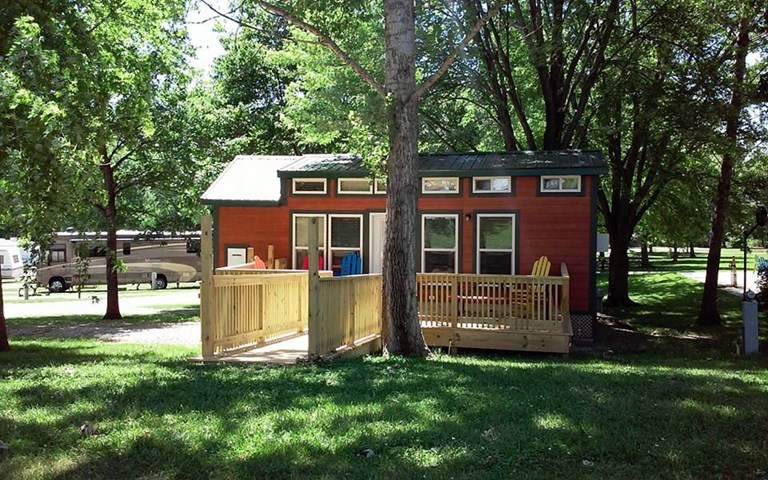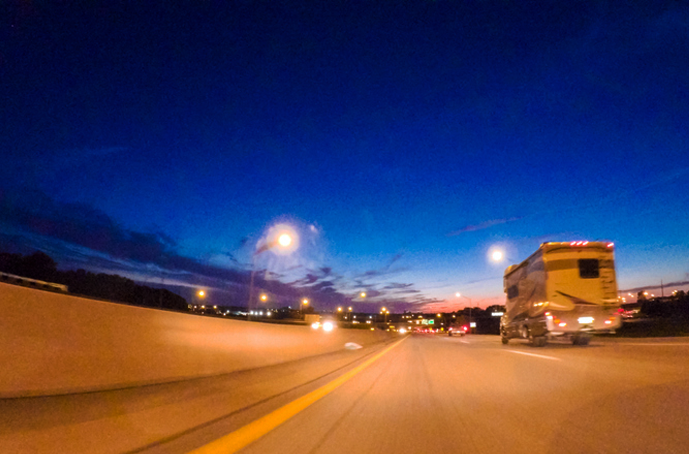Your cart is empty!
Make checkout easy by booking all your reservations at once. Add your sites from different campgrounds into your shopping cart* and then choose checkout.


Reposted from the KOA blog:
As much as we all love a good road trip in the RV, there is no denying that driving at night can pose additional risks. And sometimes you just can’t avoid driving at night. Unfortunately, the risks become even greater as you venture into areas that are more remote and where wildlife may be roaming.
However, there are some steps you can take to level-up your safety and make driving at night as safe as possible. Read on for our top tips.
Before we hop into how you can be safe while night driving, let’s take a minute to get a better understanding of why our eyes struggle at night in the first place.
Night driving means low light, which makes it harder for your eyes to identify things, such as potholes and pedestrians. The lack of light also creates a challenge in gauging distance.
Glare from things such as street signs and oncoming headlights make it more difficult to see the road in front of you. This is because your eyes require more time to adjust from the contrasting dark night and bright lights. There is a period of time between when your eyes see a light and when they actually adjust to that light and it is often referred to as “driving blind.”
The inability to see clearly causes a delay in your reaction time to different things on the road, such as something crossing the road or a car hitting its brakes. Drivers make several different decisions every mile that they drive, and those decisions become more difficult when vision is impaired.
As we age, our ability to see at night declines which increases our risk.
Our eyes get tired after hours of use, and when you drive for hours, this becomes more of an issue. Add to that the additional strain of driving at night and your eyes will be downright exhausted.
Don’t let the above scare you away from driving at night. It’s good to be aware of what challenges you face while driving, and then learn how you can best work with them to make night driving as safe as possible.
Here’s what you can do to stay safe while night driving.
There are no ifs, and, or buts about this one. Every time you stop to get gas, clean your windshield. And we aren’t just talking about the outside, we are also talking about the inside. The outside needs to be clear of bugs and other dirt, and the inside needs to be clear of streaks and oil.
A little trick for cleaning the interior of your windshield is to use a newspaper that won’t leave lint behind as a paper towel will.
For your eyes to best focus on the lights on the road, you need to minimize the lights on the inside of your RV that are in use. This means overhead lights in the RVs, lights from screens, really anything that you as a driver can see in your vision.
Because your reaction time is affected by the lack of light while driving at night, you have less time to stop if something happens. By slowing down even 5 miles per hour, you get more time to stop. However, be sure you aren’t slowing down too much because this can be a hazard for other drivers on the road.
When there are no oncoming lights, put on those high-beam headlights. They help improve both the distance you can see and the width you can see on the road.
If you’ve got an RV with foglights and have ever wondered why they exist, now is the time to learn. Foglights provide a great way to light a wider range of the road but in low light that is safe for oncoming cars. Their name is a bit of a misnomer because they provide much more value and usage than just when there is fog.
Many people remember to keep their windshields clean, but the headlights are something that often gets forgotten. Over time the plastic covers on headlights develop a film or haze on them that lowers the amount of light that can be put out. This inhibits your ability to see at night. Solve this problem by polishing or replacing the headlight covers.
Did you know that you can adjust your headlights and aim them in a specific direction? Well, you can. Depending on how your RV is loaded, you will want to change where your headlights are aimed. If your RV is back-heavy, your headlights may be angled up too high. Take the time to pull over and get the setting just right to maximize visibility.
This should go without saying, but many times people hop behind the wheel even when they’re sleepy just because they need to get to a destination. We don’t even need to tell you all the dangers that are involved in this. If you feel even the slightest bit sleepy, find someone else to drive or wait until the next day.
To stay awake while driving, steer clear of using cruise control. While it can be a great feature during the day, at night it will make you feel like you don’t need to pay attention as much and may find yourself dozing off.
Sitting closer to the steering wheel ensures you stay more upright and don’t lay back when diving. This also helps to keep your leg more bent and less loose and relaxed.
The warmth makes us cozy and sleepy, so if the temperature of your RV is there, you will want to fall asleep. Keep cooler air blowing on you while driving to help keep you awake.
Having music to sing along with or someone to talk to are both great ways of keeping you awake at night.
Getting up and stretching regularly throughout your drive helps to keep your blood flowing, your body moving, and your energy levels up.
In case you didn’t know, your dashboard or control panel in your RV has a dimming feature on it that keeps your eyes from having to constantly adjust between the bright lights of your speedometer and the road.
Some animals are more active at night, so keep on the lookout for animals that may feel this is a safe time to cross the road. This is a great thing to have a co-pilot help you with
Driving at night doesn’t have to be terrifying and dangerous. If you follow the right precautions, it can be a beautiful time to drive and a quick way to get to your next destination. There is less traffic at night, and fewer distractions to pull off the road to check out.
And if something ever does happen while you’re on the road, know that you are safe as a member of our partner Allstate Motor Club. With this membership, you get 24-hour emergency service and access to savings on things including:
That doesn't mean this area has to always be empty. When you start reviewing camping options, your history will display here to help compare sites and find the best stay. You will be able to share your stay information with friends or family and save it for a later time if you have a KOA Account.
Make checkout easy by booking all your reservations at once. Add your sites from different campgrounds into your shopping cart* and then choose checkout.